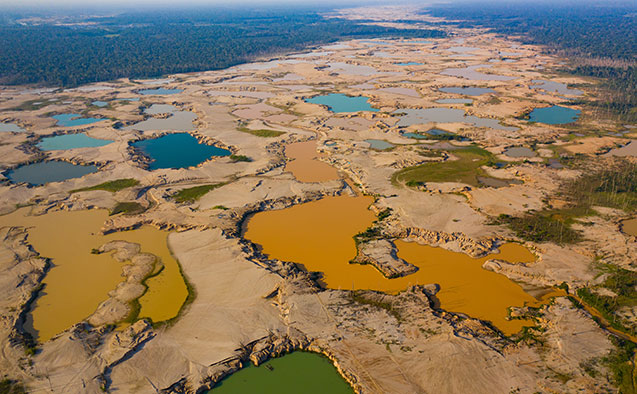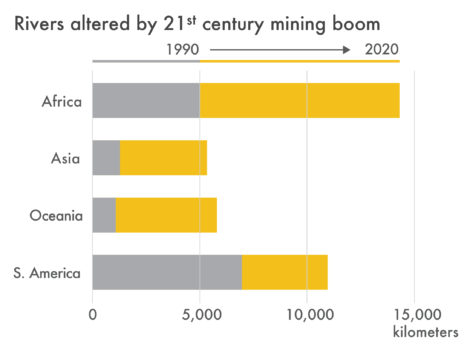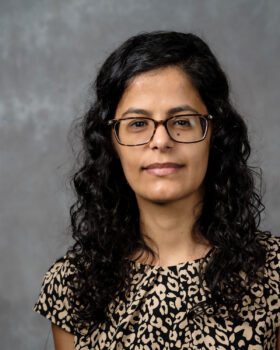Mining boom endangers rivers around the world
WFU researchers collaborate on groundbreaking study with global implications

Gold and mineral mining in and near rivers across the tropics is degrading waterways in 49 countries, according to a new study by a team of researchers including Wake Forest University biologists and computer scientists in its Center for Energy, Environment and Sustainability (CEES).
Published in Nature, the study presents a global picture of how sedimentation caused by mining is negatively impacting rivers from South America to central Africa to east Asia.
The Wake Forest CEES team collaborated with lead author Evan Dethier, an Occidental College assistant professor, who worked on the study while he was a postdoctoral researcher at Dartmouth.
Wake Forest is a leader in understanding mining impacts in developing countries through Wake Forest’s Center for Amazonian Scientific Innovation (CINCIA) – including how it affects societies, landscapes and biodiversity. CINCIA research investigating the effects of gold mining in the Peruvian Amazon has been a springboard for this broader study of mining and sedimentation.

Miles Silman
The current study assessed the effect mining operations have had on the amount of suspended sediment in tropical rivers distributed across the globe.
“While our prior work has reported on how artisanal and small-scale gold mining in the Madre de Dios region of the Peruvian Amazon poisons wildlife and people and destroys the landscape, this study raises the problem to a global level,” said Miles Silman, the Andrew Sabin Family Foundation Professor of Conservation Biology at Wake Forest and co-author of the study.
How mining creates suspended sediment
River mining often involves intensive excavation, which results in deforestation and increased erosion. Excavated material from mining is released to rivers, disrupting aquatic life in ecosystems nearby and downstream. This inorganic sediment, particles of clay, silt and sand, is carried by rivers as suspended sediment, transmitting the environmental effects of mining downstream. Suspended sediment may also carry toxins such as mercury used in gold mining processes, which further affects water quality and can be detrimental to human health and the environment.
“For hundreds, if not perhaps, thousands of years, mining has been taking place in the tropics but never on the scale like we’ve seen over the past two decades,” said Dethier. ”The degradation of rivers from gold and river mining throughout the topics is a global crisis.”
About the research
For the first part of the study, the researchers conducted a comprehensive analysis of river mining across the tropics from 1984 to 2021. The team …
- analyzed information from social media mining company reports and satellite and aerial images from Landsat 5 and 7 via the NASA/United States Geological Survey Landsat program and Sentinel-2 data, in addition to public sources.
- recorded more than 7.5 million measurements of rivers worldwide to map mining areas, and deforestation and sediment impacts; and
- identified target minerals at the mining sites.
 The results show that there are approximately 400 individual mining districts in 49 countries across the tropics. More than 80% of the mining sites are located within 20 degrees of the equator.
The results show that there are approximately 400 individual mining districts in 49 countries across the tropics. More than 80% of the mining sites are located within 20 degrees of the equator.
The team found a major uptick in mining in the 21st century, with the emergence of mining at 60% of the sites after 2000, and 46% after 2006, coincident with the global financial crisis.
For the second part of the study, the researchers assessed the magnitude that mining operations have had on the amount of suspended sediment in affected tropical rivers. To detect the transport of suspended sediment the team applied algorithms that they developed during the past seven years.
The data shows that more than 35,000 kilometers of tropical rivers are affected by gold and mineral mining around the world, more than doubling the sediment load in 80% of the 173 rivers studied.

Paúl Pauca
Wake Forest computer science professors contribute their expertise to the broader project in developing new machine learning techniques for earth observation and managing huge data sets.
“Satellites are circling the earth and generating terabytes and terabytes of data,” said Wake Forest computer science professor Paúl Pauca. “But, they are just numbers. The collaborative study allows computer scientists like us to apply computational methods to a world problem – putting together technology with end-line applications.”

Sarra Alqahtani
Pauca, along with Wake Forest colleagues Sarra Alqahtani and Seda Camalan, work with co-researchers on methods for combining available satellite data with “labeled data” – what is a river, what is a pond, where is active mining taking place – to train the algorithms and turn numbers into usable, understandable information.
“It was this intersection of expertise that really allowed us to address this global problem in a way that neither group would have been able to do independently,” Silman said. “Mining used to be something we could only see when it caused a change in forested landscapes. Now there are tools that have brought this ‘dark mining’ to light.”
Effects on fish
To evaluate the ecological impact of river mining in the tropics, the team examined environmental management guidelines used in the U.S. and elsewhere and applied the standards to their data. They found that two-thirds of the rivers represented in the study exceeded the turbidity guidelines for protecting fish on 90% of the days or more, meaning the cloudiness of the rivers was higher than the recommended guidelines.
“When rivers and streams experience high levels of suspended sediment, fish are unable to see their prey or predators and their gills may become choked with sediment and damaged, which can lead to disease or even mortality,” said senior author David Lutz, who was an undergraduate student of Silman’s and served as a postdoctoral fellow with Wake Forest’s Center for Environment, the Environment, and Sustainability (CEES) before joining the faculty at Dartmouth.
A push for solutions
The good news: the study may lead to more effective solutions.
“Each country has lessons to share,” Silman said. “We don’t have to start from zero. We can connect the lessons of South America to the lessons of Myanmar, the Philippines and the Congo.
“The future is taking local lessons and sharing them globally.” Miles Silman, Andrew Sabin Family Foundation Professor of Conservation Biology
Co-researcher Luis Fernandez, Wake Forest research professor and CINCIA executive director, is also optimistic about the effect of the findings.
“This is a clarion call to increase the velocity of our solutions to keep up with the speed of the problem,” said Fernandez. “This study will provide a greater awareness of the global scale of the problems created by mining for rivers, and that creates a greater pressure to remedy these problems. This work gives us hope that if you’ve got the right policies and they’re put into place at the right time, you can reverse the trend and basically go against the current.”
The project was funded by NASA’s Land Cover Land Use Change Program under award 80NSSC21K0309, Dartmouth’s Neukom Institute for Computational Science, and NASA’s ROSES Program under award 80NSSC23K1293.
Categories: Top Stories
Wake Forest News
336.758.5237
media@wfu.edu
Meet the News Team
Headlines
Wake Forest in the News
Wake Forest regularly appears in media outlets around the world.




